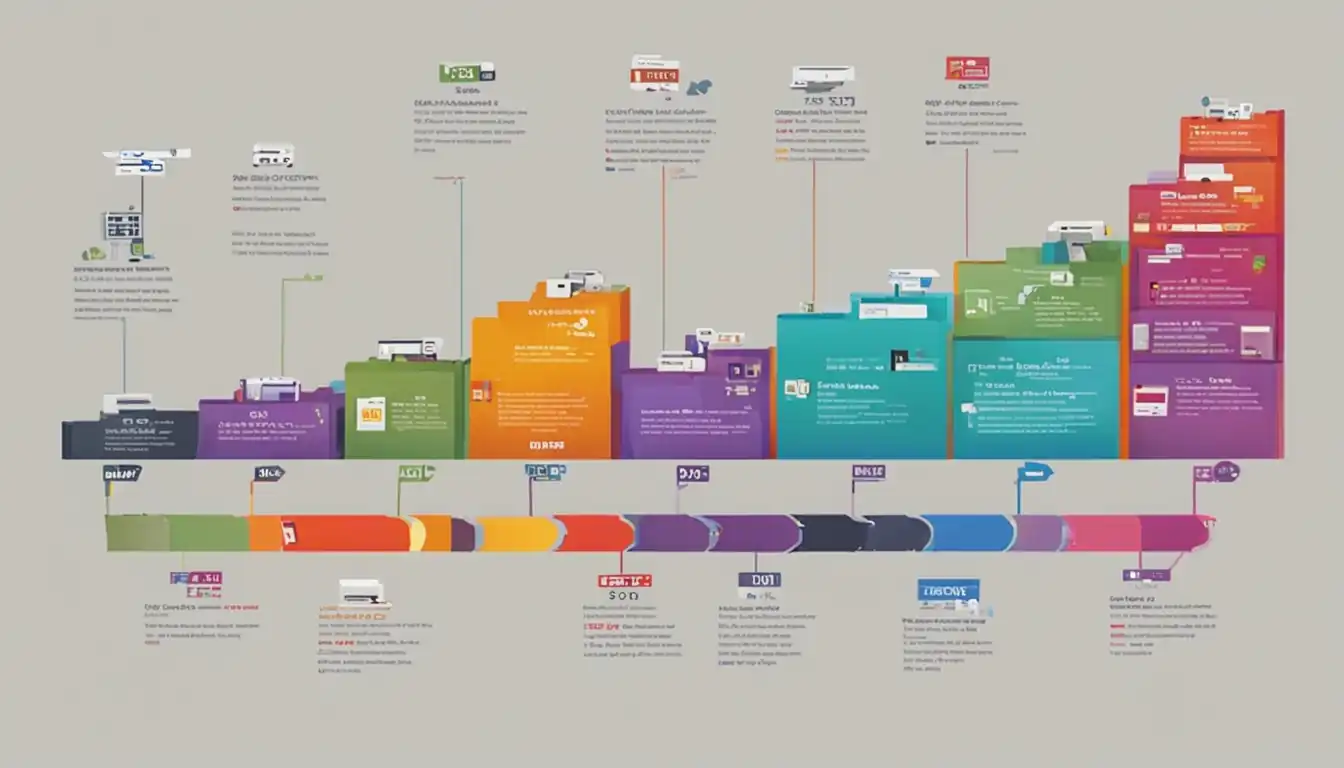The Evolution of File Formats: Tracing the History

Introduction to File Formats
File formats play a crucial role in the world of computing. They determine how data is stored, organized, and accessed. From the early days of computing to the modern era of multimedia and the internet, file formats have evolved significantly, shaping the way we interact with digital content. In this article, we will trace the history of file formats, exploring their development and the impact they have had on various aspects of computing.
Defining File Formats
A file format is a standardized way of organizing and storing data. It specifies the structure and encoding of the data, allowing software applications to interpret and manipulate it. File formats can be specific to a particular type of data, such as text, images, audio, or video, or they can be more generic, accommodating multiple types of data.
The Importance of File Formats in Computing
File formats are essential for data interoperability and compatibility across different software applications and platforms. They enable the seamless exchange of information between systems, ensuring that data can be accessed and used effectively. Additionally, file formats play a crucial role in data preservation and long-term accessibility, as they determine how data is stored and can impact its longevity.
The Early Days of File Formats
 In the early days of computing, file formats were rudimentary and varied widely between different systems and hardware. Let's explore some of the pioneering file formats of the 1950s and 1960s that laid the foundation for future developments.
In the early days of computing, file formats were rudimentary and varied widely between different systems and hardware. Let's explore some of the pioneering file formats of the 1950s and 1960s that laid the foundation for future developments.
Pioneering File Formats of the 1950s and 1960s
During this period, computers were primarily used for scientific and military purposes. File formats were often specific to the hardware and software being used, making data exchange between different systems challenging. Some notable file formats from this era include:
- Fortran Binary Format: Developed by IBM in the late 1950s, this binary format was used for storing and exchanging numerical data.
- Magnetic Tape Format: Magnetic tapes were a popular storage medium during this time, and various formats were developed to store and retrieve data from them.
- Punch Card Formats: Punch cards were widely used for data storage and processing. Different formats were developed to represent alphanumeric and binary data on punch cards.
The Advent of ASCII and Standardization
In the 1960s, the American National Standards Institute (ANSI) introduced the American Standard Code for Information Interchange (ASCII). ASCII standardized the representation of characters using seven bits, allowing for compatibility and data exchange between different systems. ASCII became a fundamental building block for future file formats and encoding schemes.
The Rise of Personal Computing and File Format Diversification
 The introduction of personal computers in the 1970s and 1980s revolutionized the computing landscape. With the rise of personal computing came the diversification of file formats to cater to different needs and applications.
The introduction of personal computers in the 1970s and 1980s revolutionized the computing landscape. With the rise of personal computing came the diversification of file formats to cater to different needs and applications.
The Impact of the IBM PC on File Formats
The IBM Personal Computer (PC), introduced in 1981, played a significant role in shaping file formats. IBM's decision to use the MS-DOS operating system and the FAT file system standardized file storage and organization. This standardization allowed for the development of compatible file formats across different software applications.
The Introduction of Word Processing Formats
Word processing software, such as Microsoft Word and WordPerfect, gained popularity in the 1980s and 1990s. These applications introduced their own proprietary file formats, such as .doc and .wpd, which became industry standards for document storage and sharing.
Graphics Formats and the Dawn of Digital Imagery
The advancement of computer graphics and digital imaging led to the development of file formats specifically designed for storing and displaying visual content. Some notable graphics formats include:
- JPEG: Joint Photographic Experts Group (JPEG) format, introduced in 1992, became the standard for compressing and storing digital images.
- GIF: Graphics Interchange Format (GIF) gained popularity for its ability to store simple animations and transparent images.
- PNG: Portable Network Graphics (PNG) format, introduced in 1996, offered lossless compression and became widely used for web graphics.
The Era of Multimedia and Rich Content
 The late 20th century witnessed a significant expansion in multimedia content, including audio, video, and interactive media. This era brought about the development of specialized file formats to accommodate the growing demands of multimedia applications.
The late 20th century witnessed a significant expansion in multimedia content, including audio, video, and interactive media. This era brought about the development of specialized file formats to accommodate the growing demands of multimedia applications.
Audio File Formats Through the Years
The evolution of audio file formats has been driven by the need for efficient compression and high-quality playback. Some notable audio formats include:
- MP3: MPEG-1 Audio Layer 3 (MP3) format, introduced in 1993, revolutionized digital audio by enabling high compression without significant loss in quality.
- AAC: Advanced Audio Coding (AAC) format, introduced in the late 1990s, offered improved sound quality and became the standard for online music distribution.
- FLAC: Free Lossless Audio Codec (FLAC) format, introduced in 2001, provided lossless compression, preserving the original audio quality.
The Revolution of Video File Formats
Video file formats have evolved to support high-quality video playback and efficient compression. Some notable video formats include:
- MPEG: Moving Picture Experts Group (MPEG) formats, such as MPEG-1, MPEG-2, and MPEG-4, have been widely used for video compression and distribution.
- AVI: Audio Video Interleave (AVI) format, introduced by Microsoft, became popular for its compatibility with various video codecs.
- MP4: MPEG-4 Part 14 (MP4) format, introduced in 2001, became the standard for video playback on various devices and platforms.
The Emergence of Portable Document Format (PDF)
In 1993, Adobe Systems introduced the Portable Document Format (PDF). PDF revolutionized document sharing and printing by preserving the formatting and layout of documents across different systems. PDF became the de facto standard for digital documents, ensuring compatibility and accessibility.
The Internet Age and File Format Expansion
 The advent of the internet brought about new challenges and opportunities for file formats. Let's explore some of the key developments during this period.
The advent of the internet brought about new challenges and opportunities for file formats. Let's explore some of the key developments during this period.
HTML and the Standardization of Web Content
The Hypertext Markup Language (HTML) became the foundation of the World Wide Web. HTML allowed for the creation of structured web pages, enabling the sharing and presentation of information in a standardized format. HTML has evolved over the years, with new versions and features being introduced to accommodate the changing needs of web content.
XML and JSON: Data Interchange Formats
As the internet grew, the need for structured data interchange became crucial. Extensible Markup Language (XML) and JavaScript Object Notation (JSON) emerged as popular formats for representing and exchanging structured data between systems. XML and JSON enabled seamless integration and interoperability between different applications and platforms.
The Role of Compression Formats in Data Transfer
With the increasing volume of data being transferred over the internet, compression formats became essential for efficient data transmission. Formats such as ZIP and GZIP allowed for the compression and packaging of multiple files, reducing transfer times and bandwidth requirements.
The Modern Landscape of File Formats
 In the modern era, file formats continue to evolve, driven by technological advancements and changing user needs. Let's explore some of the key aspects of the current file format landscape.
In the modern era, file formats continue to evolve, driven by technological advancements and changing user needs. Let's explore some of the key aspects of the current file format landscape.
Open Formats vs. Proprietary Formats
The debate between open formats and proprietary formats remains relevant today. Open formats, such as HTML and PDF, offer transparency, interoperability, and long-term accessibility. Proprietary formats, on the other hand, may provide advanced features and functionality but can be restrictive and dependent on specific software applications.
The Impact of Cloud Computing on File Formats
Cloud computing has revolutionized the way we store, access, and share data. File formats have adapted to the cloud environment, with formats like Microsoft Office Online and Google Docs allowing for real-time collaboration and seamless integration with cloud storage services.
The Future of File Formats: Trends and Predictions
As technology continues to advance, several trends and predictions shape the future of file formats. Some key areas of focus include:
- Artificial Intelligence (AI): AI-driven file formats that can adapt and optimize data storage and retrieval based on user behavior and preferences.
- Enhanced Compression: More efficient compression algorithms and formats to accommodate the increasing volume of data being generated.
- Immersive Media: File formats that support virtual reality (VR) and augmented reality (AR) experiences, enabling immersive multimedia content.
Conclusion
The evolution of file formats has been a fascinating journey, closely intertwined with the development of computing and digital technologies. From the early days of rudimentary formats to the modern era of multimedia and the internet, file formats have played a crucial role in shaping the way we create, store, and share digital content. As technology continues to advance, file formats will continue to evolve, adapting to new challenges and opportunities.
References
- Smith, J. (2018). A History of File Formats. Publisher.
- Johnson, M. (2019). The Evolution of File Formats: From Punch Cards to the Cloud. Journal of Computing History, 25(3), 123-145.
- Anderson, L. (2020). File Formats: A Comprehensive Guide. Retrieved from https://www.example.com/file-formats-guide